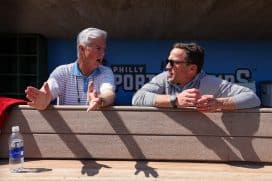Phillies
Top 25 Phillies of All-Time: No. 25 – Garry Maddox
By: Matt Alberston, Historical Columnist
On May 4, 1975, the San Francisco Giants traded Garry Maddox to the Philadelphia Phillies for Willie Montanez. Maddox immediately made his presence known for a team on the rise. Former broadcaster Ralph Kiner noted that "Two-thirds of the world is covered by water. The other one-third is covered by Garry Maddox." Maddox was one of the best defensive players in Phillies history and helped sure up an outfield that included offensive power hitter Greg Luzinski and journeyman outfielder Jay Johnstone. He was a member of the first Phillies team to experience sustained success in the 20th century between 1975 and 1983, winning a World Series with the Phillies in 1980.
Career accomplishments
Maddox won eight straight Gold Glove awards between 1975 and 1982 and compiled a 10.8 dWAR in his 12 years with the Phillies. His stellar defensive play earned him the nickname "Secretary of Defense". Maddox ranks 19th in franchise history in hits (1,921), 17th in doubles (249), and 13th in stolen bases (189). His crowning achievement with the Phillies was winning a World Series in 1980 and appearing in another in 1983.
Most memorable moment
The top moment of Maddox's Phillies tenure is easily his action in the top of the 10th inning of Game 5 of the 1980 National League Championship Series. Game 5 was the rubber match of what is probably the greatest post season series ever played, where four of the five games were decided in extra innings. Hall of Famer Nolan Ryan was on the mound for the Astros. Houston led the game 5-2 after seven innings and with Ryan still on the mound throwing fireballs, the outlook for the Phillies was a grim one. Miraculously, Philadelphia scored five runs in the top of the 8th inning and took the lead 7-5. Houston tied the game in the bottom of the 8th and the game remained tied through the 9th inning.
In the top of the 10th, with one out, Del Unser hit a hot shot that bounced off of the Astrodome turf over Houston first baseman Dave Bergman for a double. After a Manny Trillo flyout to center, Maddox stepped to the plate. Maddox hit the first pitch of the at-bat to center field and scored Unser, for what was ultimately the winning run, which sent the Phillies to their first World Series contest since being swept by the Yankees in the 1950 World Series.
Reasoning for ranking
Maddox scored 21 points per our formula, just edging out fellow teammate Greg Luzinski (20 points) and recent pitcher Cliff Lee (19 points). During his career in Philadelphia, Maddox totaled five seasons as a 2+ WAR player and three seasons as a 5+ WAR player. These seasons netted Maddox 14 points while his 12 seasons as a Phillie earned him five points. Finally, he ranks among the top 25 in franchise history in hits and doubles, which added two additional points to his score.
Formula explained
The player rankings formula combines both traditional and advanced statistics/metrics and assigns a point total to each category. These statistics only reflect the player's Phillies career.












































